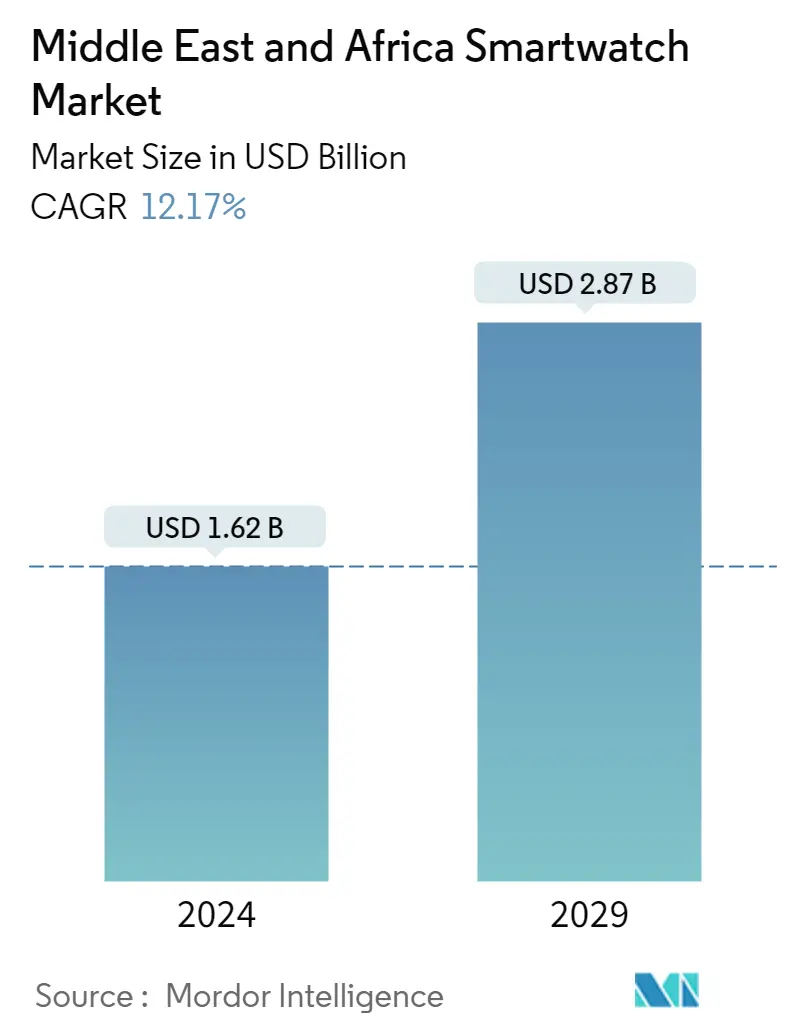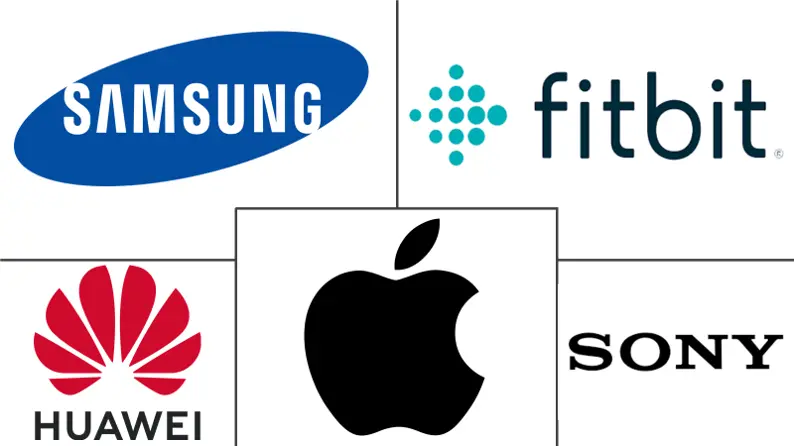Market Size of Middle East and Africa Smartwatch Industry

| Study Period | 2021 - 2029 |
| Base Year For Estimation | 2023 |
| Market Size (2024) | USD 1.62 Billion |
| Market Size (2029) | USD 2.87 Billion |
| CAGR (2024 - 2029) | 12.17 % |
| Market Concentration | Medium |
Major Players
*Disclaimer: Major Players sorted in no particular order |
MEA Smartwatch Market Analysis
The Middle East and Africa Smartwatch Market size is estimated at USD 1.62 billion in 2024, and is expected to reach USD 2.87 billion by 2029, growing at a CAGR of 12.17% during the forecast period (2024-2029).
Owing to the rising penetration rates of urbanization, the demand for aesthetically appealing advanced products that can better serve the consumers' requirements, such as time schedules and multiple features in one device, has been driving the demand for smartwatches.
- Moreover, the enormous millennial population in the region has been adopting smartwatches due to the increased spending for their regular work hours tracking and luxury standards.
- With the number of connected wearable devices in the Middle East & Africa expected to reach 46 million by this year (according to Cisco), the region's wearables market is in the midst of a significant transformation. The market is witnessing a transition from fitness bands to smart wearables like watches.
- South Africa is expected to be the next big market for smartwatches. The adoption level of wearable technology needs to improve in South African households. However, this will likely increase as the technology becomes more widespread and affordable. According to Samsung Enterprise Mobility, smartwatches and other wearables may soon move from consumer devices to valuable enterprise tools. South African CIOs are preparing to manage and secure the wave of new enterprise technologies. They are anticipated to provide massive opportunities for vendors in the forecast period.
- Moreover, the senior population suffering from numerous diseases is creating a shift in-home care toward a more precision-based personal care model. For instance, the Middle Eastern population is aging rapidly. As aging is one of the primary risk factors for cancer, the incidence and prevalence of that disease are growing among all the people in the region. According to the UN figures, it is predicted that the MENA population will increase from 443 million to 654 million by 2050. It is expected that almost 18 million people over the age of 60 will live in the GCC by 2050, representing 25% of the total population and a significant increase in the current number.
- The region's aging population may require constant monitoring, thus, driving the demand for new smartwatches for health tracking purposes during the forecast period. The region is witnessing demand for smartwatches for healthcare purposes. Numerous new use cases are gaining traction, and users are increasingly able to see the health and fitness benefits that wearables can provide.
- The recent outbreak of COVID-19 across the region has affected various significant industries. The shutdowns of production plants have greatly affected the electronics industry. However, sales of wearables are expected to improve with a greater adoption rate in the post-COVID-19 period.
MEA Smartwatch Industry Segmentation
A smartwatch is a wearable electronic device with computed capabilities for specific functions and closely resembles a wristwatch. Owing to the type of application it is used for, and in addition to displaying the time, most smartwatches have wireless communication capabilities that a user can use from the watches interface to initiate and answer phone calls, read emails and messages, receive weather report updates, dictate emails or text messages, or use it as a personal digital assistant.
The Middle East & Africa Smartwatch market is segmented by Operating Systems (Watch OS, Android/Wear OS), Display Type (AMOLED, PMOLED, and TFT LCD), Application (Personal Assistance, Medical, Sports), and Country.
The market sizes and forecasts are provided in terms of value (USD billion) for all the above segments.
| By Operating Systems | |
| Watch OS | |
| Android/Wear OS | |
| Other Operating Systems |
| By Display Type | |
| AMOLED | |
| PMOLED | |
| TFT LCD |
| By Application (Qualitative Analysis) | |
| Personal Assistance | |
| Medical | |
| Sports | |
| Other Applications |
| By Country | |
| United Arab Emirates | |
| Saudi Arabia | |
| South Africa | |
| Rest of Middle East & Africa |
Middle East and Africa Smartwatch Market Size Summary
The Middle East and Africa smartwatch market is experiencing significant growth, driven by increasing urbanization and the demand for multifunctional, aesthetically appealing devices. The region's large millennial population is adopting smartwatches for both work and luxury, contributing to the market's expansion. The transition from fitness bands to smart wearables, such as smartwatches, is a notable trend, with South Africa emerging as a potential growth hub. The market is also witnessing a shift towards using wearables as enterprise tools, with companies preparing to manage and secure these technologies. Additionally, the aging population in the region is driving demand for smartwatches with health tracking capabilities, as they offer solutions for remote patient monitoring and precision-based personal care.
The competitive landscape of the Middle East and Africa smartwatch market is marked by the presence of international brands like Apple, Samsung, and Huawei, which are continually launching new products with advanced technologies. The market is also seeing strategic partnerships and investments aimed at enhancing digital health services and accelerating digital transformation. The introduction of innovative products, such as Huawei's wrist-type ECG and blood pressure monitoring device and Fitbit's next-generation wearables, highlights the focus on integrating health and wellness features. The rise in internet subscriptions in the UAE further supports market growth, providing opportunities for expansion. Overall, the market is poised for substantial growth, driven by technological advancements, changing consumer preferences, and strategic initiatives by key players.
Middle East and Africa Smartwatch Market Size - Table of Contents
-
1. MARKET INSIGHTS
-
1.1 Market Overview
-
1.2 Industry Value Chain Analysis
-
1.3 Industry Attractiveness - Porter Five Forces
-
1.3.1 Bargaining Power of Suppliers
-
1.3.2 Bargaining Power of Buyers
-
1.3.3 Threat of New Entrants
-
1.3.4 Threat of Substitutes
-
1.3.5 Intensity of Competitive Rivalry
-
-
1.4 Assessment on the Impact of COVID-19 on the Market
-
-
2. MARKET SEGMENTATION
-
2.1 By Operating Systems
-
2.1.1 Watch OS
-
2.1.2 Android/Wear OS
-
2.1.3 Other Operating Systems
-
-
2.2 By Display Type
-
2.2.1 AMOLED
-
2.2.2 PMOLED
-
2.2.3 TFT LCD
-
-
2.3 By Application (Qualitative Analysis)
-
2.3.1 Personal Assistance
-
2.3.2 Medical
-
2.3.3 Sports
-
2.3.4 Other Applications
-
-
2.4 By Country
-
2.4.1 United Arab Emirates
-
2.4.2 Saudi Arabia
-
2.4.3 South Africa
-
2.4.4 Rest of Middle East & Africa
-
-
Middle East and Africa Smartwatch Market Size FAQs
How big is the Middle East and Africa Smartwatch Market?
The Middle East and Africa Smartwatch Market size is expected to reach USD 1.62 billion in 2024 and grow at a CAGR of 12.17% to reach USD 2.87 billion by 2029.
What is the current Middle East and Africa Smartwatch Market size?
In 2024, the Middle East and Africa Smartwatch Market size is expected to reach USD 1.62 billion.

